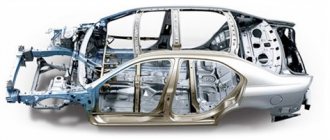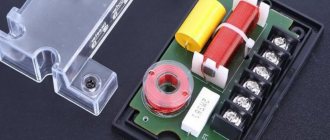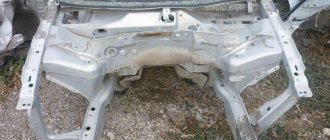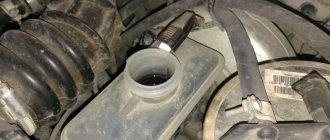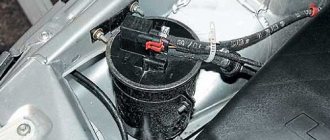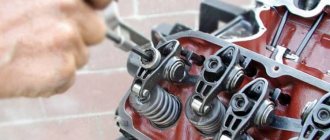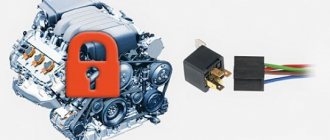On trucks and older vehicles, you can see a small metal bucket hanging from the side or at the stern. If on cars these are just small miniature metal souvenirs, then on trucks these are full-fledged buckets, the purpose of which remains unclear to many drivers. Let's talk in more detail about why drivers hang a small bucket on the back of their car.
Several versions of the appearance of this tradition
The first hypothesis for the emergence of the tradition of hanging a metal bucket on trucks is explained by the fact that in the past, when horse-drawn transport was most common, small buckets of grease or tar were hung on carts to lubricate the creaking wooden wheels. It is quite possible that at the beginning of the last century, drivers adopted this habit, carrying a small bucket on the rear beam or towbar mount, in which oil or other technical liquids were stored.
There is also a practical explanation for this tradition. When operating a car in the far north, the diesel fuel often froze in the tank, so starting the car was only possible by lighting a small fire under the frozen gas tank. The easiest way to do this is to have a small metal bucket on hand containing coals or dry wood chips. Such a bucket was set on fire, the gas tank froze, the driver quickly started the car, and then easily put out a small fire in a metal bucket.
The third version of the origin of this tradition of carrying a small bucket with you comes from lovers of outdoor activities and tourism. In such a small container it was possible to transport water that was used for drinking or household needs. In such a case, such a bucket was made closed and sealed, which made it possible to prevent water contamination when traveling by car, even on country roads.
What do people do in garages if almost no one parks cars there?
Every day in the morning I drive along the same route: from the house to the garage. And in my city there are so many garage cooperatives that some people believe that there are as many cars as there are garages in all the city buildings. You can look at the photo - these “anthills” begin at the very top and for at least a kilometer down there are rows to the right and left. descent to my garage cooperative
At the same time, on each row you can count up to 50 garages, and sometimes more (depending on the cooperative).
sometimes up to hundreds of garages on one row
And many can rightly note that today almost no one leaves their car in garages. Yes, there are still such drivers, but most often these are elderly people who have nowhere to go, and they need a car once a week, or even less often. And it’s inconvenient now: leave your vehicle in the garage and walk another 1, 2 or even 5 km to your house.
And you can often see garages whose gates are overgrown with grass, and you can immediately see that no one has been using it for a long time. And there are quite a lot of similar ones.
abandoned garages are not uncommon
But nevertheless, there are many “living” garages that their owners constantly use. But what are they doing there if they are not using them for their intended purpose?
- Some people use it instead of a pantry, storing unnecessary junk there or things that simply don’t fit in the apartment. Bicycles, baby strollers. various remnants of building materials after repairs, etc.
- Since most of these premises have basements under the entire area, food storage is also a fairly common picture. And many people are not going to sell their garage precisely because of the basement.
- Warehouses. Recently, there have been a lot of people who work for themselves, and they often use such garages as a warehouse. For building materials, things, spare parts or even equipment. Very convenient and cheap compared to regular commercial real estate.
- Car service. This is probably one of the most common types of activities at GSK, and here everyone does what they are good at: some do diagnostics, others specialize exclusively in repairing steering racks, and others open a tire shop.
- Automatic disassembly is not so common, but in my city, almost every fifth GSK has its own disassembly. I personally have been doing dismantling for 7 years now, and it’s very convenient: minimal rent, no problems with neighbors (you don’t bother anyone, unlike a private house), and convenient access roads.
There are, of course, several other types of activities that can be organized in the garage, but such businessmen are often then taken away in jail in a police UAZ, so we won’t talk about them
A metal bucket is a common souvenir
If initially such metal buckets were used by truckers and drivers of all kinds of agricultural machinery, then later small-sized metal souvenir buckets became popular with car owners. Of course, hanging such a metal bucket on an executive sedan or sports coupe with low ground clearance will be problematic and simply stupid, but on an SUV or a full-fledged crossover it will be an original and unusual accessory.
Such a small metal bucket will not have any practical value; it is just a decoration for the car and a way to emphasize the originality of the car owner. Owners of vintage cars often do this, paying tribute to the driving habits that were in fashion in the fifties and seventies of the last century.
On sale you can choose original versions of such metal buckets, made forged or branded for specific cars. In the latter case, such accessories will be an excellent gift for every car owner. At the same time, it is not at all necessary to carry them on a tow bar; they can be used to store various devices, oil and other technical fluids, which they carry in small cans in the trunk of a car.
Types of balls
There are several types of balls. It depends on the load and preferences of the drivers. Each of them has its pros and cons. The ball on the towbar can be of the following type:
- Ball H;
- Type A ball;
- Type F;
- Type C;
- Ball G;
- Ball V.
Type H is one-piece and cannot be separated from the rest of the tow bar. Product drawing A shows a removable ball, which is secured with two bolts in a horizontal plane. Type F is typically fastened with two bolts. They are located horizontally so that their axis coincides with the axis of movement of the car. Type C is detachable and can be dismantled if necessary. Attached with a coupling that makes it easy to separate. The ball drawing G differs from F in that four bolts are used for fastening. Type V is similar to F but has a longer shape.
You can make a ball yourself if you have a drawing
But this is problematic if you take into account that all requirements must be met. If desired, the drawing can be found using the Internet
Cap
The cap on the towing element of a car is not only a decoration, but also a means of protecting the part from environmental influences and mechanical damage. Rain, dirt, ice, road reagents, and hail destroy the car's paintwork. Corrosion begins to develop in areas where the paint is damaged. Because of this, the trailer hitch loses its properties and attractive appearance.
A doll's head or other custom-made decorations can be used as a cap for the ball. Such accessories have various shapes and designs, and are also capable of protecting the vehicle’s trailer hitch.
Accessories
The set of accessories for American towbars is as follows:
- Insert with ball. If necessary, the part is used in the towing device, inserted into the appropriate niche and secured with a bracket. The diameter of the ball in American versions of the trailer hitch is 50.8 millimeters. For Russian and European cars, a ball with a diameter of 50 millimeters is used.
- The American square comes with a metal or rubber plug that is inserted into the hole from the towbar. It protects the element from contamination, moisture and corrosion.
- Towbar footrest: inserted into the niche for the American square. Accessories for an American towbar can be purchased at auto parts stores or designed yourself.
The American square is not widely used among domestic drivers. This is due to the differences between the standard trailer hitch and the American towbar. Thus, the trailer hitch sockets have a different design, which requires additional modifications from drivers. When installing an American square frame on a car model that is not suitable for such equipment, you will need to drill holes for additional fasteners. Also, due to differences in the diameter of the balls of American and conventional towbars, difficulties may arise with the operation and installation of the American square.
What is a towbar
This device is designed to interface trailers and other wheeled loads with the vehicle. The ball located in the upper part is used for fixation. The fastening and strength of the material are calculated in accordance with the direction and magnitude of the load. The ball and the entire structure as a whole are subject to vertical and horizontal forces. Mechanical stresses arise in each part, which do not remain constant when the car moves. Sharp impacts require a large margin of safety. The coupling of the towbar to the machine is usually carried out using threaded connections. Some cars are equipped with this device from the factory, others need to install it yourself. To do this, you need to know the characteristics of the machine. They depend on engine power, strength of gearbox components, wheels, etc. This information can be found in the owner's manual. In accordance with the data obtained, the desired product is selected and installed.
Why do they hang a bucket on the tow bar?
Photo: Boris Zakharov/https://rg.ru
On VKontakte, 44% of survey participants voted for the answer “Somehow it happened,” and the answers “A bucket is used to wash a car” and “From the evil eye” each received 22% of the votes. 16% of respondents believe that the bucket is hung “for beauty.” Among the subscribers there were also those who answered the question themselves. Valentina Valentinova says that she saw several times how: “Passers-by threw coins into such miniature buckets.” “So that it would fly off and hit the rear windshield,” replied Roman Odarchenko. In Odnoklassniki, the majority of respondents chose the answer: “Somehow it happened.” Alla Sapova decided to dilute her thoughts with a poetic line: “There’s a bucket hanging under the bumper, it doesn’t give you peace...))))).” And Natalya Arkova shared a link to an article from an automobile magazine.
We didn’t waste any time during the survey either. And they found the answer. To do this, I had to make an excursion into history. The tradition of placing buckets on the back of vehicles originated in the days of horse-drawn transport, Rossiyskaya Gazeta reports. Cab drivers attached a bucket of tar to the rear of their carts or chaises, which was used to lubricate the hubs. Or it was always possible to water a draft animal from a bucket.
When cars appeared, the tradition of carrying a bucket with you continued, only now the container was used to scoop up water from a river, well or pump and add it to the radiator. Moreover, in winter this had to be done often. After all, to prevent the water from freezing on cold nights, it was drained in the evening, and in the morning the already warm liquid was poured back into the radiator. The same bucket was used to heat water and diesel fuel.
This also happened - a bucket was often used instead of a warning triangle, placed behind the stern in the event of a car breakdown or accident
They also often went out onto the road with a bucket when the tank ran out of fuel - it was easier to attract attention and indicate their intentions: it was immediately clear that the driver was asking to pump out five liters of gasoline or diesel fuel for him so that he could get to the nearest gas station
These days, the bucket can still be seen under the rear axle of trucks, most often truckers. The latter use such a container to rinse headlights, lanterns, windshields, wash license plates, or wash their hands after repairing or changing a tire. Often, SUV drivers - jeepers, tourists and fishermen - also benefit from buckets behind the stern. This practice is also understandable. In field conditions, you can boil water in a bucket (for example, for fish soup) and even start a fire - in windy weather it is much more convenient to do this in a bucket.
Surprisingly, today you can also see buckets under the bumpers of modern cars, most of which, however, are small, decorative and not even always made of steel. Cars are decorated with such attributes for good luck.
After all, over many years of drivers using buckets, the latter have acquired the function of a kind of amulet, promising an accident-free trip. And finally, by hanging a bucket under the bumper, drivers indicate that they are looking after their car and are ready to help other road users in emergency situations. Thus, it is also one of the symbols of the automobile fraternity.
Like
Accessories
When driving behind a vehicle, you may notice strange objects on the tow bar. At times, they cause suspicion and irony.
Some car owners install eggs on the tow bar. It looks very funny and lifts the mood. The practical purpose of such an attribute is not entirely clear. Some people simply hang them on a chain. By the way, in the USA this phenomenon occurs quite often. It is believed that cowboys used to hang them on their cars in order to show their advantage. Some companies can make eggs for you upon request. In addition, they are on sale. This product can also be used for practical purposes. For example, provide a drawing of a ball, and according to its dimensions, they will make a cap for the towbar in the shape of eggs. You can make the drawing yourself, it's simple. Observing different cars, you can see metal eggs, which can also be ordered from someone for production by providing their drawing. The presence of an object in the shape of a man's testicles on your car will be perceived differently. Some will just laugh, others will think it’s strange. One way or another, this object has a vulgar connotation, especially if it appears to the eyes of small children, or worse, girls.
Bucket
Why do you need to hang a bucket on a tow bar? This can be explained from a practical point of view. Its presence there has another meaning. Truck drivers used to take a bucket to the tow bar with them. It is very easy to guess why they did this. The fact is that at high temperatures the engine became very hot. The fan couldn't cope with the task of cooling enough to prevent boiling. Therefore, I had to add water to the radiator. It was necessary to take a bucket with you to the tow bar in order to drain the water in winter so that it would not freeze or destroy the radiator tubes. In addition, starting a cold engine became easier if hot water was poured into the cooling system. When traveling, it was very practical to hang a bucket also because you could wash the glass if there was water nearby and wash your hands.
With trucks everything is clear, but why drivers of modern passenger cars hang a bucket on the towbar is a mystery. Some people do it simply as a symbol or talisman. There is an opinion that by doing this, jeep drivers want to show the high cross-country ability of their vehicle. Others emphasize brutality.
So, on the trailer attachment you can see the following items:
- Simple cap;
- Bucket;
- Eggs;
- Caps in the shape of different animals or doll heads.
If desired, a practical application can be found for any item, including those that seem useless. The best combination of all will be the aesthetics and practicality of a particular item.
Legends and opinions
Some fairly elderly people, who have older examples of the domestic automobile industry, keep such an accessory in memory of wonderful times behind the steering wheel, as a souvenir. Usually the bucket is hooked to a device that is designed for towing various trailers. As you can see, this is an old custom and should have had at least some explanation.
Main myths:
- Digging deeply into the historical jungle, it turns out that the bucket was in village carts and in carriages for gentlemen. At that time, horse-drawn carts were mainly used on the streets of any Russian city. It was still a long time before the invention of bearings, so instead of an assembly unit, a respected cab driver had tar lubricant for the hub. Many drivers still consider it a kind of talisman when traveling on the road.
- The second version is more practical. Experienced truck drivers and road train drivers in the northern part of the country have more than once encountered diesel fuel freezing. There is only one thing left, to melt the diesel fuel, it was necessary to make a fire under the tank where the fuel is located. This is where the treasured bucket will help, because on a long flight it is the only means available for starting a fire on the road asphalt.
Male power on the towbar
By the way, drivers abroad hang part of their male organs on the tow bar, apparently in order to convey male strength to the car and confidence to the driver. In our country, this, frankly speaking, not the most aesthetic talisman is not very common. Although we also have drivers who believe in the power of this particular symbol. On social networks you can find many offers of chrome-plated, multi-colored towbar accessories costing about 1,000 rubles.
Text: Sergey Mikhailov.
Welcome!
A bucket hanging on the back of a car - many have already seen this situation when, for example, you are driving behind any car and there is an iron metal bucket hanging behind it, it’s small, it’s true, but why is it hanging there? Many people ask this question, and many already know the answer to it (Older generation of people), since this thing was very common before 2000, after 2000 such buckets are becoming less and less common, but why are they being advertised? Now we'll figure it out!
A little about the history of this bucket!
Many will now begin to say that this is not beautiful, but still people will continue to broadcast them, which means there is something difficult about this, right? In fact, everything is correct, there is a benefit from this bucket (or rather, there was benefit before), when there was no normal antifreeze and antifreeze as such (or rather, they existed, but they cost a lot of money and not everyone could fork out for normal coolant in those days) , people poured into the cooling tank not the same coolant that everyone is already accustomed to now, but simply ordinary water drawn from a tap or from a pump and this water was poured into the tank, thereby the car heated up less and was cooled only from water alone.
